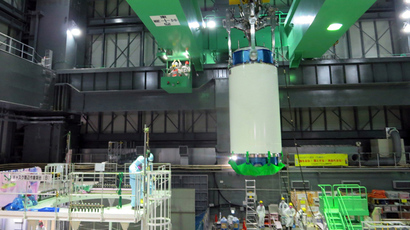IAEA suggests Fukushima consider ‘controlled discharge’ of toxic water into ocean

The UN nuclear watchdog has advised the Fukushima Daiichi nuclear power plant to consider dumping toxic water into the ocean after lowering the level of radioactive materials to below the legal limit.
"Regarding the growing amounts of contaminated water at the
site, TEPCO should... examine all options for its further
management, including the possibility of resuming controlled
discharges (into the sea) in compliance with authorized
limits," the International Atomic Energy Agency (IAEA) said
in a statement.
"To pursue this option, TEPCO should prepare appropriate
safety and environmental impact assessments."
The IAEA advice reflects the bind Tokyo Electric Power Co has
found itself in as it attempts to manage the risks between
holding greater quantities of contaminated water in storage tanks
versus dumping partially decontaminated water into the ocean.
Local residents and commercial fishing interests have strongly
resisted efforts to drain the water into the sea.
Juan Carlos Lentijo, who headed a team of 19 experts that arrived
on November 25 to check the decommissioning efforts, told a news
conference in Tokyo that public approval was “necessary” before
going forward, Japan Times reports.
Lentijo, director of the IAEA’s Division of Nuclear Fuel Cycle
and Waste Technology, added that strict monitoring of the impact
of the discharge would be necessary.
Despite local opposition to the plan, Lentijo added that
“controlled discharge is a regular practice at all nuclear
facilities in the world.”
Radioactive water has been leaking from the damaged reactors and mixing with groundwater since an earthquake and tsunami in 2011 destroyed the plant's power and cooling systems, causing three reactors to melt and damaging a fourth reactor building. So far, around 400,000 tons of highly contaminated water is being stored in approximately 1,000 tanks at the site. Leaks and other flaws found in several tanks earlier this year have raised concerns about more failures, especially if another earthquake or typhoon were to hit the area.

The IAEA review, which evaluated the management of contaminated
water that has been used to cool reactor cores, as well as work
on removing fuel assemblies from the spent fuel pool in Reactor
No. 4, noted progress had been made since their last visit this
past spring.
"The team considers that since our previous mission in April this
year, Japan has achieved good progress in improving its strategy
and in allocating necessary resources to conduct a safe
decommissioning of the Fukushima Dai-ichi nuclear power
station," Lentijo said, after concluding the inspection
Wednesday.
He added that the “situation remains very complex and that
there are still very challenging issues that must be solved for
the plant's long-term stability."
The IAEA suggestion comes one day after officials on the Japanese
Industry Ministry's contaminated water panel released a draft
report warning that the Fukushima Dai-ichi plant could run out of
storage space for contaminated water within two years if current
plans are not fully workable.
The report, drawing from some of 780 sets of proposals sent from around the world, suggested covering the ground with asphalt to reduce rain inflow, building giant tanks with more capacity and installing undersea filters to reduce the radioactivity of water that leaks into the sea. Experts on the panel also proposed setting up a special team to focus on how to tackle the problem of tritium – the sole isotope that cannot be removed chemically by existing technology.
Currently, 400 metric tons of highly contaminated water is being produced at the site on a daily basis. In response, TEPCO has been running a test operation of a high-tech water processing machine called ALPS, which can remove all radioactive materials from the tainted water except tritium.
In line with IAEA recommendations, the utility hopes to discharge
the processed water after diluting the level of tritium to
legally acceptable limits.














